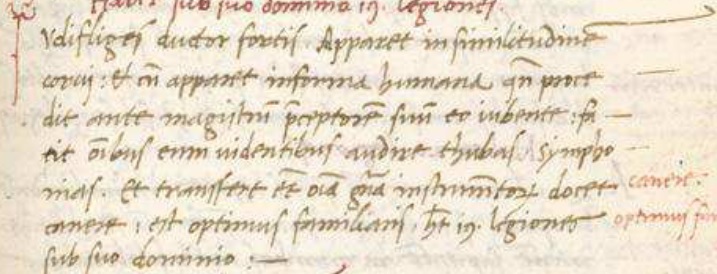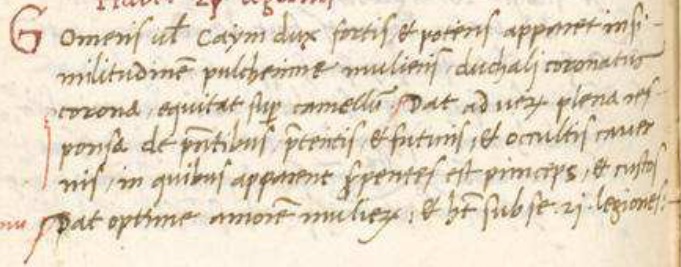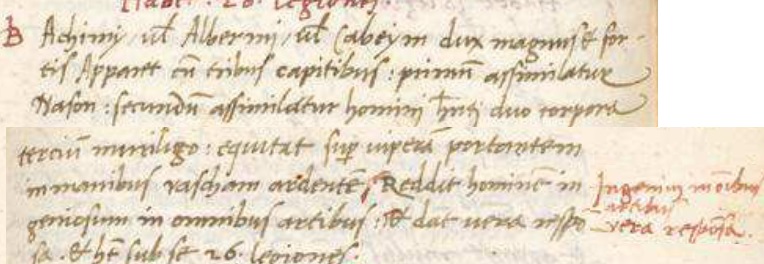Y’all know what time it is. The way I translate these is in part from google translate but also in part by recognizing repeated subject matter, similarity to other sources on demonology, and recognizing some Latin roots. I don’t have a background in this, and the source material is pretty scratchy, so… I’m going to post my translations, insofar as I have them, and you make fun of me in the comments, right?

Lanima – AKA Pneuna – is a great count, appearing in angelic seeming (smonibus blamois?) ceases, and knows strengths of herbs, and has under him 20 legions. It’s hard to pin down a demon in another source I could compare against to find meanings for those words.

Judifligei is a great duke, appearing in the likeness of ravens, and then appears in human form, preceded by teachers (preptore fui inbente?), makes heard unseen trumpets and symphonies, and transfers (et ora gna?) instruments, teaches to play, is best familars, has 19 legions in his dominion. Again, I can’t find an equivalent to him in other demonology to help here. On those ravens, I have a frustration I’ll get to in just a bit…

Gomens or Caym, a strong powerful duke, appears in the likeness of a beautiful woman, crowned with a duchal crown, riding on a camel. Gives full true responses on past present and future, on the occult (ravernis?), in which appear (spentes?) is princes, and (rustos?). Gives best love of women, and has under him 2j legions.
This is the one known as Gremory, Gomori, or a half dozen variants thereof in many other grimoires! A lovely gender weirdo on a camel. On that “spentes,” I feel like I’ve seen “serpentes” – snakes – abbreviated that way somewhere else in here, but not positive. Rustos sounds like it would mean farmers, but doesn’t come up in translate. Don’t know.

Furfur, a great count, appears in the likeness of ravens, his tail in flames, lies unless trapped in a triangle. Then can be ordered into angelic form, with a raucous voice… Here’s my problem with those ravens. Furfur is in lots of other demonologies, always described as a deer or hart. I can see how one missed transcription could lead to a chain of error, with “corvii” looking like “cervus.” Or maybe the Geomanticarum has it wrong, or I do. But if Furfur is ravens, so is Judifligei. And if he’s a deer, likewise.

This is mostly gibberish to me, but it’s clearly about Berith – here called Berich. Most demonologies open his description saying he is known by at least three names – known to the jews (lovely) as Berith, to some nigromancers or necromancers as Bolfry, and to unnamed third party as (insert random garble here). I imagine the “vocatur Salmonazi vocant” is about him being referred to in the “notary art of Solomon” as Berich. Are Gramatiri and Belfarit alternate names?

This guy is known in other demonologies as Aym or Cabeym. Here… Bachimy or Albermi or Cabeym is a great strong duke appearing with three heads. The first is like a (nason?), the second like a man (tyng?) two bodies (wtf?), third as a mouse hunter (cat), rides on a viper, carrying in hand a blazing (valcham?), makes man ingenius in all arts, and gives true responses, and has under him 26 legions. In other demonologies, the first head is a snake, the human head has two stars on it. But is a “nason” a snake? And that really looks like it’s saying one of his heads has two bodies, which is bonkers. The blazing thing elsewhere is a firebrand, but the word valcham doesn’t seem to mean shit in Latin, and reminds me of the sound of “falchion” – a kind of sword.

Simias or Gumas is a great marquis, appearing in the likeness of a lion, riding on a strong (ursum? bears?), the tail of a serpent, flames proceeding from his mouth. In his right hand carries… OK, this guy is really similar to Egyn in The Book of Oberon, The Book of Spirits, and… Also this book. In those descriptions, Egyn rides bears or a dragon, so…? I don’t know. However, he’s maybe even more similar to Orias, from the Pseudomomarchia Demonum, Lesser Key of Solomon, and other sources – and that guy rides a horse. I may be overthinking this one.

Ras, a great governor, appears in the likeness of a (cervi?) with then a subsequent human form, speaking gravely. Belvow (?) makes subside, and limp. Gives true responses, gives grace of friends, has under him LX9 legions… Whatever, buddy.
I hope this one, being Latin, draws as much attention as the previous posts – and doesn’t get whiffed on like the Italian Demonds. Thank you for what help you’ve already given me. It is imperative that I summon these demons, pronto. I swear.
–

1. Lanima, ut pneumam, magnus comes, apparet in ange-
lica specie, sermonibus blandis aloquitur, et cognovit
vires herborum, et habet sub se 20 legiones
Lanima, or Pneuma, a great count, appears in an
angelic countenance, speaking with pleasant speech, and understands
the powers of herbs, and has under him 20 legions.
(“anima” is the Latin word for soul, and pneuma the Greek word, so clearly this one has some connection with souls in general)
2. Iudifligei, ductor fortis, apparet in similitudine
corvis: et tum apparet in forma humana quando proce-
dit ante magistrum praescriptorum suum eo iubente: fa-
cit omnibus enim videntibus audire thubas sympho-
nieis. et transfert tunc omnia genera instrumentorum docet
canere; est optimus familiaris, habet 19 legiones
sub suo dominio
Iudifligei, a strong leader, appears in the likeness
of a crow. And then he appears in human form, when he proceeds
in front of his previously mentioned master, with him giving the orders. He even
makes it so that all looking on hear the trumpets of
a symphony. And then he brings forth all kinds of instruments and teaches how to play them.
He is the best companion. He has 19 legions under his dominion.
(I have translated it as “companion”, but “familiaris” can mean all kinds of things depending on context. Without any kind of institutional setting it can be a friend, companion or acquaintance. In a modest domestic setting it can mean a family friend, member of the household or domestic servant. In a grander, courtly, setting, it could be a majordomo, chancellor or chief minister.)
3. Gomeris, ut Cayim, dux fortis et potens apparet in si-
militudine pulcherrimae mulieris, duchali coronatis
corona, equitat super camellum. Dat ad verum plena res-
ponsa de praesentibus, praeritis et futuris, et occultis cavernis
in quibus apparent serpentes est princeps et custos.
Dat optime amorem mulierum, et habet sub se 2i legiones.
Gomeris, or Cayim, a strong and powerful duke, appears in
the likeness of the most beautiful woman, crowned with a
ducal crown, riding upon a camel. He gives to the true
full responses about the present, the past and the future, and
he is the lord and guardian of the hidden caves in which
snakes are found. He gives the love of women very well indeed,
and has under him 21 legions.
4. Furfur magnus comes apparet in similitudine
cervi: cauda eius sicut flamma: mendax est omnibus
nisi intromittatur inter angulum: sed tunc ibi fuerit
suscipit angelicam formam, loquitur rauca voce
Furfur, a great count, appears in the likeness
of a deer: his tail like a flame. He lies to all
unless placed in a corner, but then in that place
he will take on angelic form. He speaks with a harsh voice.
(cervi and corvi, the genitive forms of cervus and corvus, are very similar, and could easily be confused by an inattentive scribe. “curvi” is just possible I suppose, and that would be a crooked or bent person or thing – maybe a crook-backed old man. Seems doubtful though. I’d go with the goat on this).
5. Nunc autem dicendum est de Berich. Berich, autem, rex est
et dux magnus inter omnibus vocatur Salomonazi
vocant ipsum hoc nomine Berich: Gramatici nomine Balfayit
Now, however, we must speak of Berich. Berich, however, is a king
and is called a great duke by all. The followers of Solomon
call him by this name, Berich: the learned by the name Balfayit
(I’m assuming “Salomonazi” means something like “followers of Solomon”. I’ve not come across that form before, but the distinctively hebraic -azi ending suggests that kind of thing. “grammatici” are simply learned men)
6. Bachimy, ut Albermi, ut Cabeyim, dux magnus et fortis,
apparet cum tribus capitibus: primum assimilatur Nason:
secundum assimilatur homini habenti duo corpora. Tercium muriligo
equitat super viperam portantem in manibus
vas der am ardentem. Reddit hominem ingeniosissimum in omnibus artibus
et dat vera responsa. et habet sub se 26 legiones.
Bachimy, or Albermi, or Cabeyim, a great and strong duke,
appears with three heads: the first is likened to a (Nason?):
the second is likenend to a man with two bodies, The third to a bat.
He rides upon a viper, carrying in his hands a burning (razor?).
He makes a man most clever in all the arts and gives true responses.
He has under him 26 legions.
(“duo corpora” can mean two bodies in the loosest of senses too, not just two human chests and abdomens. It could be two celestial bodies, or just two lumps)
(“murilingo” is not the usual Latin word for bat, which is vespertilio, but it is a Spanish word for bat derived ultimately from the Latin mus caecus – blind mouse – so I’m guessing a 15th century writer would imagine it was used in Latin as it is in Spanish).
As for what “Nason” and the word that is probably a firebrand are… I’m fairly stuck too. “Nason”, capitalised, looks very much like an oblique case of the name Naso, which is Ovid’s family name. But I don’t think they meant the demon’s head looked like Ovid. Maybe it’s a type of snake I’ve not seen in a Latin text before. Maybe (like Murilingo) some kind of Romance back-formation. Just possibly to do with noses (nasus).
Comparing the letters, I’m not sure that is a v at the beginning of the other word. Looks more like an R to me. ras (dh) am. That dh ligature contraction looks familiar, but I can’t find it in any reference work I have to hand. ras- tends to come from the verb rado (to shave or scrape) in Latin, so maybe some kind of blade or razor? Again, really not sure. I’ll keep thinking.
7. Simias ut Gurnas, magnus marchio apparet in simi-
litudine leonis: equitat super fortissimum, cauda eius
serpentina, flamma ex ore eius progreditur: in dextra portat
Simias, or Gurnas, a great Marquis, appears in the likeness
of a lion. He rides on a very strong bear, his tail is
snake-like, a flame comes forth from his mouth. In his right
hand he carries…
(ursum looks ok for his steed, but the initial letter isn’t quite as curved as other examples in the text, so I’m not 100% sure. I can’t think of a better idea)
8. Ras, magnus preces, apparet in similitudine (???)
cum autem suscipit humanam formam loquitur grave:
beluas facit languescere et claudicere. Dat
vera responsa. Dat gratiam amicorum. Habet
sub suo domino LX9 legiones.
Ras, a great President, appears in the likeness of (???)
when, however, he assumes human form, he speaks
in a deep voice. He makes beasts grow sluggish
and walk unsteadily. He gives true responses.
He gives the thankfulness of friends. He has
under his dominion 69 legions.
It could be cervi. I don’t like that, though, as the second letter looks much more like an r than an e, and the third letter more like a c than an r. Just possibly “crucis” (a cross)?
Cartomancer on a storm! Hell yeah. Some reactions:
The word for their likeness in Iudifligei and Furfur looks about identical to me. Aside from the corroborating description in other sources, is there a reason you think the one looks like cervi and the other corvis?
On familiaris, there’s of course the idea of a familiar spirit from witchcraft and demonology. It is funny to think the loser wizards reading these books need 90% of the demons to provide friends or house staff.
Snakes in caves, *beavis and butthead laugh*
I knew to put cat into google translate because Cabeym’s third head is a cat’s elsewhere, and one of the results is “murilegus,” of which wiktionary says “one who gathers mice, a cat.” Nason still a total stumper. I just looked at the scientific names of every lizard and snake in Europe to see if Linnaeus or somebody had slipped a nason in the mix. Didn’t take long, but no dice.
Thanks for the hookup diabolical! Though I wonder how much I should push my luck teasing free labor out of you.
–
No one has figured out yet what Ras should look like? That word is very weird… it could be “ctonii”, “ronii”, “rovii”… I really don’t know…
By now I’m pretty positive about “cervi.” I spent a lot of time looking at this handwriting, and I’m 95% positive about c-e-r, and maybe 70% on the v-i. So a deer, if I’m not wrong.
–